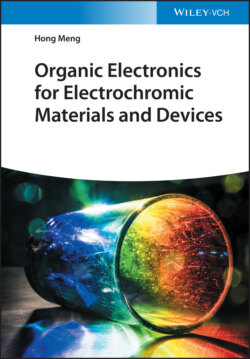Читать книгу Organic Electronics for Electrochromic Materials and Devices - Hong Meng - Страница 29
2.3.3 Cross‐linking Polymer Electrolytes (CPEs)
ОглавлениеThe high ionic conductivity of PEs at low temperature is related to the amorphous nature of the polymer matrix (Figure 2.7). The cross‐linked PEs show good ionic conductively and amorphous feature [85]. Cross‐linking was reported to improve the dimensional stability and increase the dynamic storage modulus of the PE. This technique was used to modify positively various PE properties [86, 87], while brittleness, low elasticity, and processability inevitably occur in cross‐linked polymer [88]. In the study of lithium salts‐based electrolytes, PEO, PMMA, PVC, etc. were commonly organized into cross‐linked PEs. Matsui et al. have prepared a cross‐linked PE of poly(ethylene oxide) 2‐(2‐methoxy ethoxy) ethyl glycidyl ether with and without allyl glycidyl ether P(ethylene oxide [EO]/2‐(2‐methoxyethoxy)ethyl glycidyl ether [MEEGE]/allyl glycidyl ether [AGE]) complexed in LiN(CF3SO3)2 salts [89]. Kuratomi et al. studied a cross‐linked copolymer of ethylene oxide and propylene oxide with LiBF4 or LiN(CF3SO2)2 salts [90]. The concentration and anions in lithium salts are key parameters in determining electrochemical performance. As was studied, good ionic conductivity and mechanical strength have been exhibited in a cross‐link of high molecular weight poly(oxy ethylene)s PEs [91]. Lee et al. have also reported a cross‐linked composite PE by polymerizing alkyl monomer and polyethylene glycol dimethylcrylate (PEGDMA) in LiPF6/EC [92]. The studies indicate that ionic conductivity and flexibility of the PEs are dependent on the monomer content.
Figure 2.7 Pictorial model of a preparation of a cross‐linked polymer.
In fact, while many conventional ECDs using the EC media of cross‐linked polymer gels are exposed to the dynamic range of real‐world temperatures, cross‐linked polymer gels may not be optically viable for commercial use due to visual irregularities and/or defects. The patent in 2003 reported a self‐healing cross‐linked polymer gel electrolyte used as EC medium, which could solve these detriments and complications in ECDs [92].
Another intriguing field for the possible application of ionic liquid polymers (ILPs) is using polymerized ionic liquids (PILs) in ECDs. Among different IL electrolytes, cross‐linked IL PEs have been explored recently. Yan and coworkers reported thermo‐ and electro‐dual responsive ILPs electrolytes, which were synthesized through the co‐polymerization of an ionic liquids monomer (ILM), 3‐butyl‐1‐vinyl‐imidazolium bromide ([BVIm][Br]) and N‐isopropylacrylamide (NIPAM) using diallyl‐viologen as both the cross‐linking agent and the EC material, respectively (Figure 2.8) [93]. The electro‐ and thermo‐responsive behaviors can be found simultaneously under electrical and temperature stimuli, which demonstrates the application of the dual‐response smart window [93].
Figure 2.8 (a) General synthetic routes for P(NIPAM‐fv [DAV]) IL gels and P(NIPAMBVIm‐DAV) gels and (b) a schematic mechanism of thermochromic and electrochromic devices based on the prepared polymer gels.
Source: Chen et al. [93].
